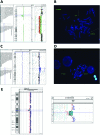New microdeletion and microduplication syndromes: A comprehensive review
- PMID: 24764755
- PMCID: PMC3983590
- DOI: 10.1590/s1415-47572014000200007
New microdeletion and microduplication syndromes: A comprehensive review
Abstract
Several new microdeletion and microduplication syndromes are emerging as disorders that have been proven to cause multisystem pathologies frequently associated with intellectual disability (ID), multiple congenital anomalies (MCA), autistic spectrum disorders (ASD) and other phenotypic findings. In this paper, we review the "new" and emergent microdeletion and microduplication syndromes that have been described and recognized in recent years with the aim of summarizing their main characteristics and chromosomal regions involved. We decided to group them by genomic region and within these groupings have classified them into those that include ID, MCA, ASD or other findings. This review does not intend to be exhaustive but is rather a quick guide to help pediatricians, clinical geneticists, cytogeneticists and/or molecular geneticists.
Keywords: chromosome rearrangement; microdeletion; microduplication; novel deletions; novel duplications.
Figures



References
-
- Bertoli M, Alesi V, Gullotta F, Zampatti S, Abate MR, Palmieri C, Novelli A, Frontali M, Nardone AM. Another patient with 12q13 microduplication. Am J Med Genet A. 2013;161A:2004–2008. - PubMed
-
- Deak KL, Horn SR, Rehder CW. The evolving picture of microdeletion/microduplication syndromes in the age of microarray analysis: Variable expressivity and genomic complexity. Clin Lab Med. 2011;31:543–564. - PubMed
-
- Engels H, Schüler HM, Zink AM, Wohlleber E, Brockschmidt A, Hoischen A, Drechsler M, Lee JA, Ludwig KU, Kubisch C, et al. A phenotype map for 14q32.3 terminal deletions. Am J Med Genet A. 2012;158A:695–706. - PubMed
-
- Filges I, Röthlisberger B, Boesch N, Weber P, Wenzel F, Huber AR, Heinimann K, Miny P. Interstitial deletion 1q42 in a patient with agenesis of corpus callosum: Phenotype-genotype comparison to the 1q41q42 microdeletion suggests a contiguous 1q4 syndrome. Am J Med Genet A. 2010;152A:987–993. - PubMed
Publication types
LinkOut - more resources
Full Text Sources
Other Literature Sources
